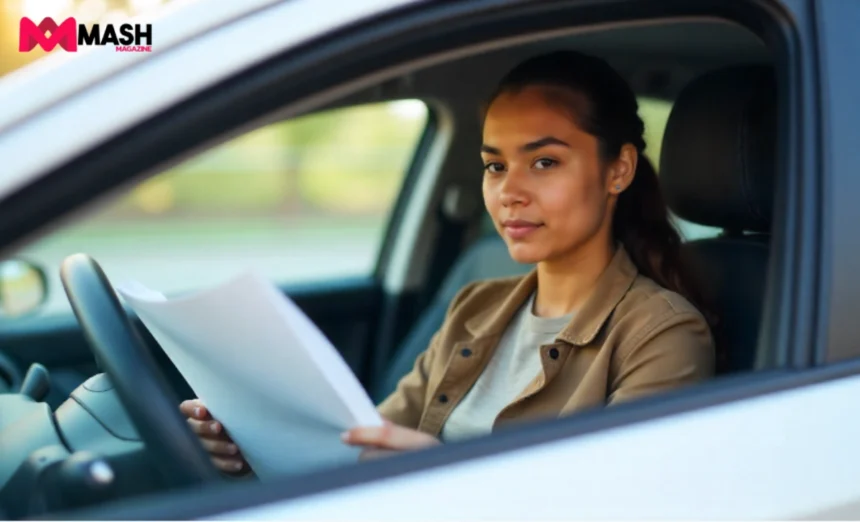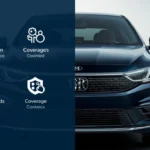Getting your first car in Australia is exciting. Then you look at insurance quotes and the excitement fades fast.
- Why do new drivers pay higher premiums
- What types of car insurance can new drivers get?
- Real example: car insurance costs for new drivers in Australia (2025)
- Example 1: 18-year-old P-plater in Sydney
- Example 2: 20-year-old full-licence driver in Brisbane
- Example 3: Adding a young driver to a parent’s policy
- How to save money on car insurance as a new driver
- 1. Choose the right car
- 2. Drive safely and build a no-claim record
- 3. Compare multiple insurers
- 4. Increase your excess (carefully)
- 5. Consider pay-as-you-drive policies
- Important insurance rules and responsibilities for new drivers
- 1. Compulsory Third Party (CTP) insurance
- 2. Registering and insuring your first car
- 3. What happens if you drive uninsured
- Common mistakes new drivers make when buying car insurance
- FAQs
- What’s the average cost of car insurance for a new driver in Australia?
- Can I be added to my parent’s car insurance policy?
- Do P-platers need different insurance than full-licence drivers?
- What happens if I have an accident in my first year?
- Is it cheaper to get insurance before or after I buy the car?
- Conclusion
New drivers face higher premiums, confusing jargon, and dozens of cover options. Most don’t know where to start. The result? They either overpay for protection they don’t need or skip coverage that protects them.
This guide walks you through car insurance for new drivers in Australia. You’ll learn what types of cover exist, what you actually need, real-world cost examples, and proven ways to cut your premiums without cutting corners on protection.
Car insurance in Australia works on one simple rule: the higher your risk, the higher your premium.
Insurers assess risk using several factors. Your age matters most—drivers under 25 have the highest accident claim rates. Your driving experience, postcode, car type, and even your job affect what you’ll pay. A 19-year-old new driver in a busy Sydney suburb will pay far more than a 19-year-old in a regional town.
New drivers also can’t build a no-claim discount. Experienced drivers get discounts for years without making a claim. You start from scratch. That’s why your first insurance quote will shock you.
In Australia, you need at least Compulsory Third Party (CTP) insurance by law. This covers injury to other people if you cause an accident. But it doesn’t cover damage to your own car or property damage you cause. That’s why most new drivers need additional cover.
Why do new drivers pay higher premiums
The numbers are stark. Drivers aged 17–25 make up about 13% of licence holders but account for roughly 25% of fatal crashes, according to transport safety data across Australia.
Insurers use this data. A 19-year-old in a hatchback might pay $2,000–$2,500 per year for comprehensive cover. A 35-year-old in the same car pays $800–$1,200. That’s a real difference.
Your inexperience is the driver (pun intended). You haven’t faced emergency situations. You’re less likely to recognise hazards. Your reaction times are slower under stress. Statistically, you’ll make more claims in your first three years of driving.
The good news? This improves. Each claim-free year, your premium drops. By age 25, even new drivers see significant discounts.
What types of car insurance can new drivers get?
Australia offers three main types of car insurance. Which one suits you depends on your car’s value, your budget, and your risk tolerance.
1. Comprehensive insurance
Comprehensive cover is the broadest option. It covers damage to your own car, damage to other vehicles or property, theft, fire, weather events, and even vandalism.
If you hit a parked car, your comprehensive policy covers both your repair costs and theirs. If hail damages your roof, you’re covered. If someone steals your car, you’re covered.
The trade-off is cost. Comprehensive premiums run 40–60% higher than third-party options. For a new 18-year-old driver, expect $1,800–$2,500 annually depending on the car and state.
Comprehensive makes sense if your car is financed, less than five years old, or worth more than $15,000. Lenders often require it anyway.
2. Third Party Fire & Theft
This sits in the middle. You’re not covered for your own damage from collisions. But you are covered if someone else hits you, if your car is stolen, or if fire damages it.
This appeals to budget-conscious drivers with older cars. A used hatchback worth $8,000 might not justify $2,000 annual premiums. Third Party Fire & Theft typically costs $900–$1,400 per year for young drivers.
The risk? If you cause an accident, you pay for your own repairs. That $3,000 repair bill comes straight from your pocket.3,
3. Third Party Property Only
The cheapest option covers only damage you cause to other vehicles or property. Your car, theft, fire, and weather damage? You pay yourself.
Annual costs can drop to $600–$900. But this only works if you can afford to replace your car or pay for repairs yourself.
For most new drivers, this is too risky. One accident could mean a $5,000+ bill you can’t afford.
Real example: car insurance costs for new drivers in Australia (2025)
Numbers matter. Here’s what new drivers actually pay across different scenarios.
Example 1: 18-year-old P-plater in Sydney
Car: Toyota Corolla, 2018 model, valued at $16,000. Coverage: Comprehensive. Annual cost: $2,100–$2,400 depending on the insurer.
This assumes no prior claims, one named driver, and a standard excess of $600. Add a second named driver (a parent) and the cost might drop to $1,900–$2,200 due to shared risk assessment.
Example 2: 20-year-old full-licence driver in Brisbane
Car: Honda Jazz, 2015 model, valued at $12,000. Coverage: Third Party Fire & Theft. Annual cost: $950–$1,200.
By age 20 with a full licence (not a P-plate), you’ll see a modest premium reduction. The older car and mid-tier cover keep costs reasonable.
Example 3: Adding a young driver to a parent’s policy
Car: Shared family car, Mazda 3, valued at $18,000. Parents’ current comprehensive premium: $800. Cost to add 18-year-old driver: +$600–$900 per year.
New total: $1,400–$1,700. This is usually cheaper than the young driver getting their own policy ($2,000+), making shared policies attractive for families.
How to save money on car insurance as a new driver
Your premium isn’t fixed. Several strategies can genuinely reduce what you pay, starting now.
1. Choose the right car
Your car choice affects your premium more than you’d think. A V6 sports car costs more to insure than a 1.6L hatchback—both in premium and repair costs.
Insurance groups rate vehicles 1–20. Group 1 (cheapest to insure) includes small hatchbacks like the Hyundai i20 or Kia Picanto. Group 20 includes high-performance vehicles. As a new driver, aim for groups 1–5.
Safety features also matter. Cars with electronic stability control, multiple airbags, and anti-theft devices cost less to insure. Check the Australasian New Car Assessment Program (ANCAP) ratings before you buy.
Real numbers: A Toyota Yaris (Group 3) might cost $1,700–$2,000 to insure comprehensively. A Ford Mustang (Group 18) could cost $3,500+. Same driver, same suburb, vastly different premiums.
2. Drive safely and build a no-claim record
A claim-free year earns you a no-claim bonus. In Australia, this typically reduces your premium by 10–20%. After three claim-free years, you’re looking at 30–40% discounts.
The maths are compelling. If your first year costs $2,000:
- Year 2 (10% discount): $1,800
- Year 3 (20% discount): $1,600
- Year 4 (30% discount): $1,400
- Year 5 (40% discount): $1,200
One accident in year two resets your discount to zero. That $200 savings you’d earned gets wiped out, and you’re back to the full premium plus a loading for the claim. Over five years, one accident costs you thousands in lost discounts.
Drive defensively. Avoid minor bumps. Your future self will thank you.
3. Compare multiple insurers
This is non-negotiable. The same cover from different insurers can vary by 30–50%.
Use Australian comparison sites like Compare the Market, Finder, or Canstar. Get quotes from the major brands: NRMA, AAMI, Youi, Bingle, Budget Direct, and Shannons (if applicable).
Spend 20 minutes getting five quotes. The $300–$500 you save annually is worth it. Some sites let you adjust excess, add optional covers, and tweak driver details to see real impacts on price.
Don’t just pick the cheapest option. Read the fine print. Some policies have stricter exclusions or lower limits on certain claims. Cheap can mean less protection.
4. Increase your excess (carefully)
Your excess is what you pay toward a claim. Standard excesses range from $300–$600. Increasing it to $800 or $1,000 can cut your premium by 10–15%.
The trade-off is risk. If you have a $800 claim, you pay the first $800. If you can’t afford that, a higher excess hurts.
Calculate the break-even point. If raising your excess saves you $150 per year, it takes five years ($750 in savings) to break even on a $1,000 excess. Only increase it if you have an emergency fund covering that amount.
5. Consider pay-as-you-drive policies
Some insurers offer usage-based insurance. You install a small device in your car that tracks your driving. Lower mileage, safer driving habits, and fewer nighttime trips can cut premiums by 10–25%.
This works best if you drive fewer than 10,000 km per year—university students, for example. If you commute 30 km daily, the savings are minimal.
Important insurance rules and responsibilities for new drivers
Australia has specific rules. Breaking them costs money and creates liability.
1. Compulsory Third Party (CTP) insurance
CTP insurance is mandatory in every Australian state. It’s not optional. Driving without it is illegal and carries hefty fines.
CTP covers personal injury only. If you cause an accident and injure someone, their medical bills are covered. It does not cover vehicle damage, property damage, or loss of income—only injury to the injured person.
Cost varies by state. In NSW, CTP for a young driver ranges from $500–$800 annually, bundled into your registration fee. In Queensland, it’s similar. In Victoria, it’s called Third Party Property Damage and covers vehicle damage to others as well.
Check your state’s transport authority website for exact CTP requirements:
- NSW: Service NSW
- Victoria: VicRoads
- Queensland: Queensland Transport and Main Roads
- South Australia: Service SA
- Western Australia: Department of Transport
- Tasmania: Service Tasmania
- ACT: Access Canberra
- NT: NT Registration Services
You cannot register your car without proof of CTP. Some insurers bundle CTP with other cover; others sell it separately.
2. Registering and insuring your first car
Getting insurance and registration right takes planning. Here’s the sequence:
First, buy a car or secure financing. Second, get insurance quotes and choose a policy. Third, pay your insurance premium and get proof of insurance. Fourth, take that proof and your car documentation to your state’s transport authority to register the vehicle and pay CTP.
You cannot legally drive without both insurance and registration. Many new drivers skip CTP thinking general insurance covers it. It doesn’t. CTP is separate and mandatory.
If you’re financing the car, the lender will require comprehensive insurance naming them as the “interested party.” You can’t skip it.
3. What happens if you drive uninsured
The penalties are severe. In most states, driving uninsured attracts fines of $1,000–$3,000 and demerit points. In NSW, it’s a $1,377 fine and three demerit points. In Victoria, it’s up to $9,000 and six demerit points.
Worse is personal liability. If you cause an accident, every dollar of damage becomes your responsibility. A $50,000 accident is your bill to pay. You have no insurer backing you up.
Real-world case: In 2024, a young Queensland driver was fined $1,100 for driving without CTP. When he caused a minor accident, the other driver sued him personally for $8,000 in repairs. He lost. No insurance meant he paid it all himself.
Common mistakes new drivers make when buying car insurance
New drivers often rush the insurance decision. Here are the mistakes to avoid.
1. Only choosing the cheapest option
Your mates tell you they pay $600 for car insurance. You see a quote for $1,200 and think you’re being ripped off.
But your mate might be on their parents’ policy (bundled discount), driving a 10-year-old car, or carrying a $1,500 excess. You’re comparing apples to pickup trucks.
Cheaper often means less coverage or higher excess. A $1,200 comprehensive policy with a $600 excess is more valuable than a $600 third-party policy with no coverage for theft.
Look at what each policy covers, not just the price tag.
2. Forgetting to update policy details
You move house. Your postcode changes. Your premium should change too—but many new drivers don’t tell their insurer.
Same with car modifications. Add a body kit, upgrade the wheels, or change the engine? Your insurer needs to know. Driving with undisclosed modifications can void your entire policy. You could have an accident and get zero payout.
Review your policy annually. Update your address, mileage estimate, and any car changes.
3. Ignoring exclusions
Every policy has exclusions. Common ones for young drivers include:
- Unlisted drivers: If you didn’t declare that your mate sometimes drives your car, claims involving them won’t be covered.
- Illegal modifications: Aftermarket turbos or lowered suspensions void coverage.
- Driving under the influence: This is never covered, regardless of policy.
- Driving outside of Australia: Your cover stops at the border (unless you bought international extension).
Read the exclusions section. If something matters to how you’ll use the car, ask your insurer before you buy.
FAQs
What’s the average cost of car insurance for a new driver in Australia?
First-year premiums typically range from $1,400–$2,500 annually for comprehensive cover, depending on age, car type, and location. Third-party options cost $700–$1,300. Costs drop significantly after age 25 and with a clean driving record.
Can I be added to my parent’s car insurance policy?
Yes. Being a named driver on a parent’s policy is often cheaper than getting your own ($600–$900 cheaper per year). The downside: any claim on the policy affects your parent’s no-claim discount, and you have less control over policy terms.
Do P-platers need different insurance than full-licence drivers?
Insurance rates are the same regardless of licence type. However, P-plate restrictions (like not driving after midnight or with more than one passenger) don’t change your insurance. Some insurers offer P-plate-specific policies with slightly lower premiums if you accept these restrictions voluntarily.
What happens if I have an accident in my first year?
Your claim gets processed normally. You pay your excess, and repairs are covered (if comprehensive or third-party fire & theft). Your no-claim discount resets to zero. When your policy renews, your premium increases due to the claim history. The loading typically lasts 2–3 years.
Is it cheaper to get insurance before or after I buy the car?
Get a quote before buying. Insurance costs vary wildly by vehicle. You might fall in love with a car, buy it, then find insurance costs twice what you expected. Getting quotes on your top choices helps you choose a car you can actually afford to insure.
Conclusion
Car insurance for new drivers in Australia is expensive—but not inexplicable. Your age and inexperience create genuine risk that insurers must price in.
The key is making smart choices. Choose an affordable car, compare quotes across multiple insurers, and increase your excess only if you can afford it. Build a no-claim record by driving safely, and your premiums will drop dramatically within three years.
Don’t skip comprehensive cover if your car is financed or valuable. Don’t ignore CTP—it’s the legal minimum and non-negotiable. Most importantly, don’t let cost blind you to coverage gaps.
Ready to get a quote? Use an Australian comparison site to pull five quotes right now. Spend 20 minutes today and save hundreds this year.






